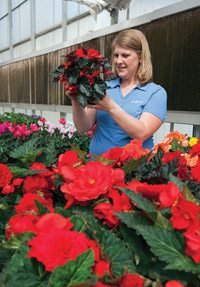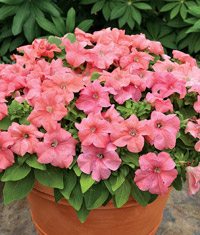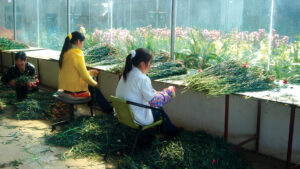The floriculture seed industry looks to recover from an economic downturn with innovative products and a dynamic marketing message.
Since the Great Recession, Americans have had less money in their pockets and, in many cases, no home or yard to spend it on due to the concurrent foreclosure crisis. As a result, the nation’s floriculture industry has had to weather some difficult economic times, with the effects impacting seed breeders and distributors as well.
As they look to recover, industry leaders aren’t banking on a “miracle cure” or some kind of new technology to revive sales. Instead, they say they are focused on meeting the wants and needs of consumers—as soon as they start spending again.

Across the board, the floriculture industry felt the effects of the recession after Americans scaled back their discretionary spending over the past five years. The drop in sales certainly didn’t come as a surprise to industry veterans. Mike Murgiano, senior market manager for Syngenta Flowers Inc., says history proves that a downturn in the housing market negatively affects the purchase of ornamentals.
Charlie Hall, professor and Ellison Chair in International Floriculture at Texas A&M University, says the biggest impact was felt in the exit of companies from the ornamental business altogether. He estimates that the number of U.S. growers has shrunk by 30 percent since the recession.
It proved to be a more pronounced loss of producers than in a typical recession, something Hall attributes to the fact that it’s been several years since the last financial crisis and the industry was in need of some “right sizing.” Beginning in the early 1980s, the floriculture industry was experiencing double-digit growth rates. The 1990s weren’t bad either, says Hall, with an average growth rate of six to seven percent.
“Now the industry has matured, and with that maturity comes some consolidation—something we’re seeing more of at the propagative and seed level. The financial pressure has hastened that. We’ve been overly good at producing plants, so much so we’ve had an oversupply in recent years. Right sizing is not all bad,” Hall says.
Some see consolidation as an effect of the recession, while others see it as an appropriate response, says Rod Stacey, a partner with the genetics industry brokerage and consulting group, Verdant Partners. “Consolidation [in the floriculture sector] is being driven by the economy of scale, not by technology like in field crops. Everyone is trying to get bigger. Everyone is trying to control the value chain all the way down to the retailer and that requires you to be of a certain size,” he says, noting that this kind of movement is being driven by both big names in the industry and private investment.
Demographics also play a role in the floriculture industry’s downturns, says Hall. The industry was built on baby boomers, but they’re now becoming senior citizens and, traditionally, consumption of floriculture products starts to decline after 65.
Economic concerns are also influencing where seed production occurs. Growing operations are spread across the globe which, Stacey says, isn’t a new practice considering that the diversity of species on the market today requires a wide range of appropriate growing conditions; however, other factors are making it more prevalent.
“We now see seed grown in places like Costa Rica, Guatemala and Chile. That’s due to favorable climates, but you could find the same conditions in the Mediterranean or California. It’s more cost-effective to go to a country where labor costs are lower,” Stacey says.
Although growing operations are expanding in places like South America, floriculture companies still maintain a significant presence in the United States. Murgiano points to the fact that Syngenta Flowers recently invested more than $8 million in their Gilroy, Calif., facility, called the Center of Excellence. The project, which began in 2011, includes new state-of-the-art greenhouses, hoop houses and a pot-filling operation. The greenhouses will be home to breeding programs for pansies, violas, geraniums and chrysanthemums, among others.

Syngenta Flowers says its new Wonderfall Pansy, a trailing variety that comes in six shades, will transform the market and satisfy consumer demand. |
Technology? Yes. Genetic Modification? No.
Genetic modification has transformed the seed industry when it comes to field crops; however, producers don’t see the same kind of potential in ornamentals. At the moment, other breeding techniques are sufficient in producing flowers with desired traits.
Although the costs associated with transgenics have dropped in recent years, Stacey says it’s still not practical for species in small markets. Some limited genetic engineering has been done, aimed at producing colors that are otherwise difficult to achieve naturally. He says the industry is more likely to benefit from mutation and computational genomics. Knowledge of genotypes and genome maps could be very helpful as well.
There are no genetically engineered seeds in Syngenta Flowers’ product line, says Murgiano. “We’re focused on using advanced breeding technologies. However, Syngenta believes that all growers should be able to choose the best technology and products in a way that will help them meet their production needs,” he says.
Murgiano points to the fact that they’re already able to produce plants with vibrant colors, better drought tolerance, hardiness and a longer bloom time without having to introduce new genetic material. It also helps that companies like Syngenta are finding good results by ramping up their vegetative reproduction practices. “Vegetative propagation has been one of the fastest growing areas for the floriculture industry as a whole over the last five to 10 years,” Murgiano says.
Harris Seeds, a Rochester, N.Y., company that sells flower and vegetable seeds to home gardeners and professional growers, has also opted not to carry GE seed. “We try to keep an open mind to technology, but have not been completely convinced that genetically modified organisms will not have long-term effects on our environment,” says company president, Dick Chamberlin.
There is also consumer perception to consider. Although these ornamentals wouldn’t be consumed like GE food crops, Stacey believes the general public might still have a negative reaction to their introduction. “I wouldn’t advise a client that there wouldn’t be any backlash,” he says.
However, that doesn’t mean consumers would never accept GE flower seeds down the road. Hall says several years ago he and a colleague asked master gardeners for their opinions on plant breeding. “We didn’t see any hesitance on their part to adopt plants that were genetically modified. What they were concerned about was invasiveness, about creating a bulletproof plant that posed the potential for becoming invasive,” Hall says.

According to the company, the Duvet compac |
Poised to Deliver
There’s a general optimism among industry leaders that the future looks brighter.
At Syngenta, Murgiano says the company’s investment in the Gilroy facility and the volume of new varieties they’ve released in recent years is evidence of their faith in a recovery. “We’ve had two really big introduction years, which is an indication of how many opportunities there are in the business,” he says, noting there were more than 100 new seed varieties in their 2012–13 catalog.
Murgiano says one of Syngenta’s goals is to offer ornamentals that are both unique and a pleasure to grow. “We know that consumers love flowers; that’s the important thing. Where they struggle is having flowers perform. We want to ‘wow’ the consumer and enhance their gardening experience, so we’re always looking for traits that will thrive. Breeding will have a lot to do with it and Syngenta is uniquely positioned to deliver that,” he says.
Commercial growers who pay attention to consumer trends continue to produce more combination pots and hanging baskets. Although home gardening may be a popular hobby, Harris’ Vicky Rupley, company vice president and ornamentals manager, says traditional flower gardens are actually decreasing in size. “More homeowners are either growing or purchasing product for containers or hanging baskets and less for garden beds. Mixed combo containers have increased in popularity over the last 10-plus years and continue to grow,” Rupley says.
Fortunately, this trend should benefit growers’ and breeders’ bottom lines, Stacey says. Pots and hanging baskets last longer than small cell-packs while on display at big box stores or supermarkets, making them more attractive to the customer and more likely to be sold.
However, Hall says growers must take into account that the next generation of consumers will have expectations that go beyond pot sizes. “We must remain relevant to the consumers of tomorrow. We have sold ourselves on being pretty, but it just doesn’t cut it anymore. We have to talk about the economic impacts, the health and well-being, and the environmental benefits that ornamentals provide,” Hall says.
“I grew up gardening with my parents and grandparents. People in the Generation X and Y years have not had that experience. Everyone in the industry must embrace some kind of education efforts to showcase the benefits of gardening and landscaping,” he adds.
Maria Brown













